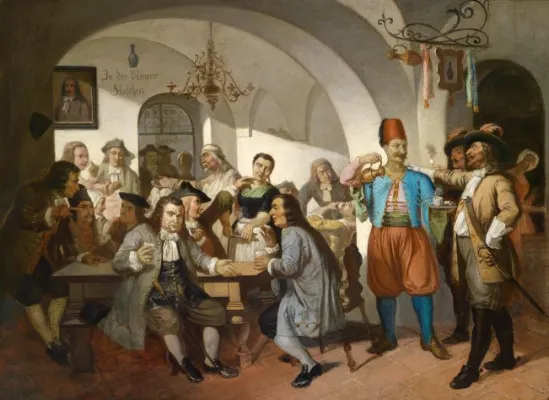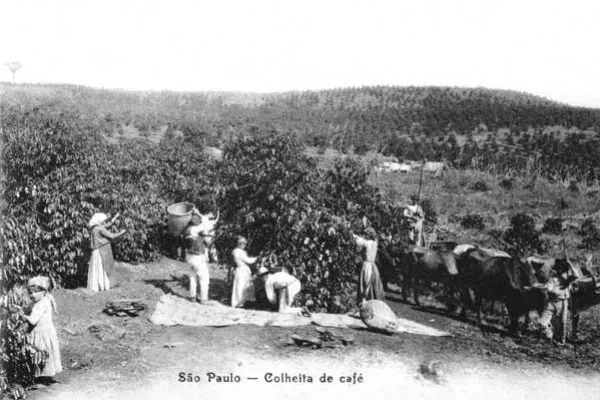
blog
Did you know that a shepherd discovered coffee by observing his goats? In Europe they called coffee "the evil drink" and in Brazil it arrived because of a fierce love affair. The cinematic history of coffee
Caldi was a shepherd in the Ethiopian mountains.
One day he noticed that his goats were much livelier when they ate the fruit of a bush that looked like cherries.
When he tried it, he was convinced that the fruit gave him more energy
He told a monk at the nearby monastery, who made a drink with the fruits and was impressed by how much alertness they gave him.
The fruits gradually spread through the region, later the country and, through traders, reached the Arabian Peninsula sometime in the 12th century.
The shepherd had discovered coffee!
The country that first developed coffee was Yemen, where they boiled the beans and made the now famous drink.
That's where the name comes from. 'Qahwa', pronounced 'kawa', was one of the words used by the Arabs for wine, which was replaced by coffee as the most common drink as alcohol was banned by Islam.
The word went through many stages and transformations, with each country using a different pronunciation, until it came to the form we know today.
The spread of coffee around the world
It became the most popular beverage not only among Arabs, but also among Persians and Turks
Venetian merchants brought it to Italy, where it was initially regarded as a 'satanic drink' until Pope Clement VIII tried it and was so delighted with the taste that he gave permission for all Christians to consume it freely.
In the 17th century, the Dutch were the first to take seeds from the Arabs, as they were banned from exporting them, in order to maintain their monopoly.
The Dutch planted them in their colonies in Indonesia.

In the same century and after the beverage had spread throughout Europe, coffee inevitably reached the "New World", America.
European settlers initially drank mainly tea, as was the custom on the old continent.
In 1773, however, when a heavy tax was imposed on tea by the British King George III, it became the patriotic duty of Americans to boycott tea, and so they turned to coffee, which to this day is the most popular beverage in the country.
The famous Brazilian coffee originated from the efforts of Francisco de Mello Palheta, who traveled all the way to Guinea to get seeds from the French colonists.
Of course they refused to sell them to maintain the monopoly, but in the end Palheta managed to secure them thanks to his charm. The governor's wife fell in love with him and the coffee beans were a trivial sacrifice for her lover. She gave them secretly and changed the history of the beverage.
That's how coffee arrived in Brazil, where due to the climate and vast land, the country now has the largest coffee production, which generates huge revenues.

The varieties of coffee
There are two main coffee crops and the types of bushes from which the fruit comes.
Arabica, also known as "Coffea Arabica", which accounts for 70% of world consumption.
Coffee has a light taste and contains a relatively low amount of caffeine.
The second crop is called 'robusta'. The plant is more resistant to hardship than Arabica and is therefore considered by many to be more productive, but of lower quality, as the coffee tastes more bitter.
From these two crops, thousands of varieties have emerged, from mutations of the plants, depending on the area where they were planted and the various mixes that growers have made.
Of course, there are now countless ways of making it, such as frappe, filter coffee, Irish coffee and many others.
In the beginning, however, it was coffee that we drank in the brewery.

The "Turkish coffee"
Although "discovered" in Ethiopia, coffee spread mainly in the Arabian Peninsula.
In the 16th century, it was brought to Constantinople by Syrian traders.
Arabic, or Greek, or Turkish, or Byzantine coffee is boiled with water for a very short time, until the two ingredients are fully mixed.
It spread throughout Europe and prevailed as one of the most popular beverages until the appearance of 'cappuccino' in the early 18th century.

The "cappuccino"
Capuchino appeared in the 18th century in Austria and became particularly popular in the countries of central Europe. It differed from 'Greek' in its method of preparation, because the coffee was filtered before it reached the glass.
It took its name from the brown robes worn by the Capuchins, an order of monks in the Catholic Church.
In Vienna, where it first appeared, it was known as 'kapuziner' and described as 'coffee with cream and sugar'.Of course, the form it took in the 18th century was very different from the cappuccino we drink today, which developed in Italy in the 20th century, alongside the invention of coffee-making machines.

The "espresso"
"Espresso" means "quick" in Italian and indeed, the popular coffee was created by an Italian, Luigi Bezzera, who was in a hurry to leave for work in the mornings.
He built a machine that ran on steam, which pushed water onto the coffee beans at tremendous pressure.
The result was a "shot" of pure coffee, with a strong aroma and taste. An invigorating drink that awakened the senses after sleep.
Since 1905, when Bezzera machines were launched on the market, espresso coffee has become the favourite of Italians.
The "capsules"
In the 1970s, Nestle employee Eric Favre travelled around Italy in search of the perfect espresso.
He found it in Rome, in the café Sant'Eustachio.
He noticed that the way the barista prepared it allowed more air to pass through, thus oxygenating the drink and releasing more flavour and aroma.
Favre returned to his native Switzerland and tried to find a way to apply the Roman barista's secret to his experiments.
Eventually he created a capsule that contained a specific amount of coffee and its packaging itself acted as a filter.
The capsule was placed in a special machine that pierced it, allowing water to pass through the coffee at high pressure and a controlled temperature.
The journey of coffee from the shepherd's goats in Ethiopia to the espresso machines is a long one, but every time we drink a cup of coffee as we wake up or tell our news to our friends, we know that in modern culture it is more than just a beverage.

